
At 5am on a Thursday morning, groggy and jetlagged, 20 of us OPENharvest participants, with
Food Light Project members piled into three vans headed for Niigata prefecture. As we drove through the quiet morning streets of Tokyo, we eagerly anticipated the adventures ahead.
Three hours and several rest stops later, we made it to Uonuma, a region of Niigata well known for the rice,
koshihikari. It is a variety of rice that is presently grown all over Japan, but it is here in
Uonuma that it originated. According to Satoshi Imai, rice farmer and owner of the Minami Uonuma Farm,
koshihikari was discovered in the wartime years, and grows best in Uonuma, due to factors such as the fresh spring water that drips down from Hakkaisan Mountain, which towers over the region; as well as the terroir, or
fuudo (watch Yoko Kumano's video on this subject
here).
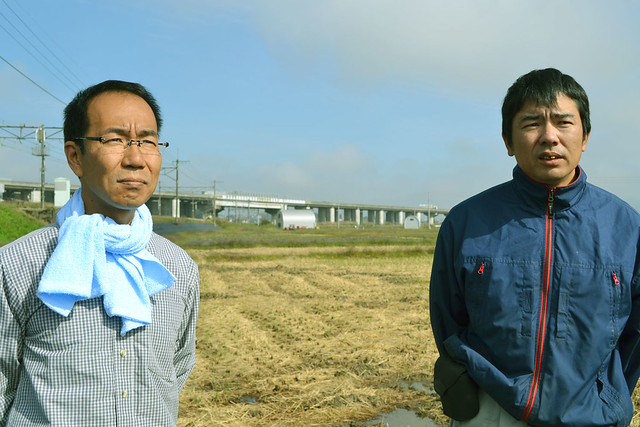 Magazine editor Toru Iwasa and rice farmer Satoshi Imai. Photo by Yoko Kumano
Magazine editor Toru Iwasa and rice farmer Satoshi Imai. Photo by Yoko Kumano
Luckily, the 3/11 disaster did not effect Niigata very much, in terms of farming and production. This surprised me, given how close the prefecture is (just due east of Fukuoka), but there is a large mountain range that divides this part of the country, so they lie on separate seismic plates. Good to know!
We were warmly welcomed to Minami Uonuma Farm, and the field full of rice crops ready for harvesting.
 Photo by Kelly Ishikawa
Photo by Kelly Ishikawa
We grabbed our tools, and slipped on some rain boots. The sun, just starting to peek out from the fog, warmed our faces; the air, crisp and clear, boasted the beginnings of autumn. We were ready for action.
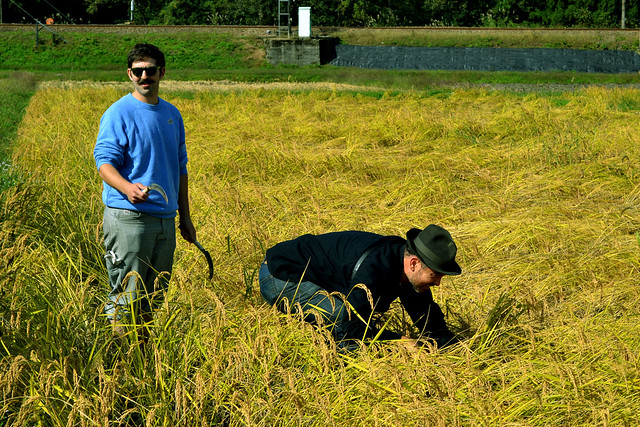 OPENrestaurant co-founder Sam White and Pizzaiolo's Charlie Hallowell. Photo by Yoko Kumano
OPENrestaurant co-founder Sam White and Pizzaiolo's Charlie Hallowell. Photo by Yoko Kumano
 Barefoot Sam White. Photo by Kelly Ishikawa
Barefoot Sam White. Photo by Kelly Ishikawa
Chez Panisse chef and OPEN co-founder Jerome Waag explains the steps for collecting the rice:
http://www.youtube.com/watch?v=J1PzwVH5lJk
Video by Kayoko Akabori
About two bunches of crops equals one bowl of rice. There was enough rice here to comfortably feed a family, maybe even a small village, until the next harvest.
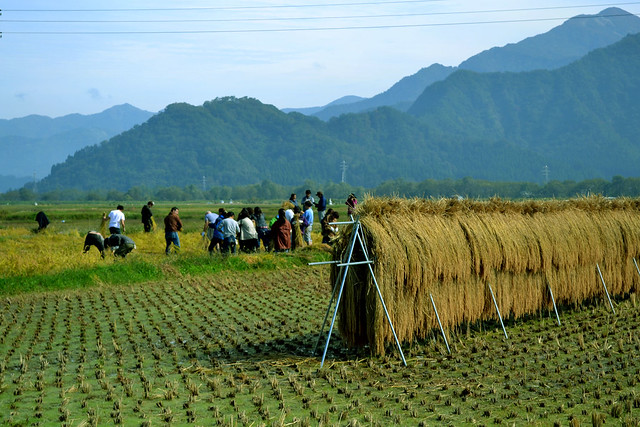 Photo by Yoko Kumano
Photo by Yoko Kumano
Cultivating rice is extremely difficult. From the moment it is planted, it must be watched with keen, observant eyes, getting a feel for the land and all of its uncertainties. The fields are flooded numerous times, and it takes months of careful cultivation to produce each grain. Crops are laid down in April, ready for harvest in late September. In the harsh winter months here in Niigata, the fields are covered with nearly ten feet of snow! This means it is a time for the soil to rest, and get ready for the next planting season.
 Mack Yokokawa. Photo by Kelly Ishikawa
Mack Yokokawa. Photo by Kelly Ishikawa
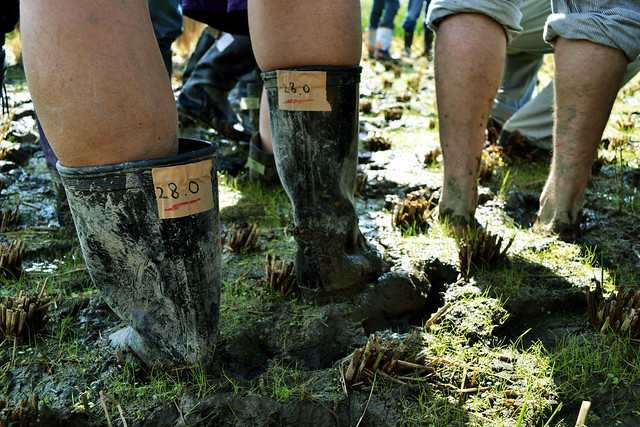 Photo by Yoko Kumano
Photo by Yoko Kumano
 Photo by Kelly Ishikawa
Photo by Kelly Ishikawa
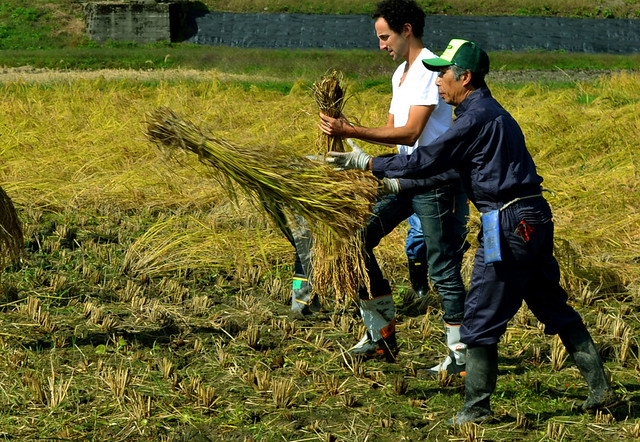 David Wilson and rice farmer. Photo by Yoko Kumano
David Wilson and rice farmer. Photo by Yoko Kumano
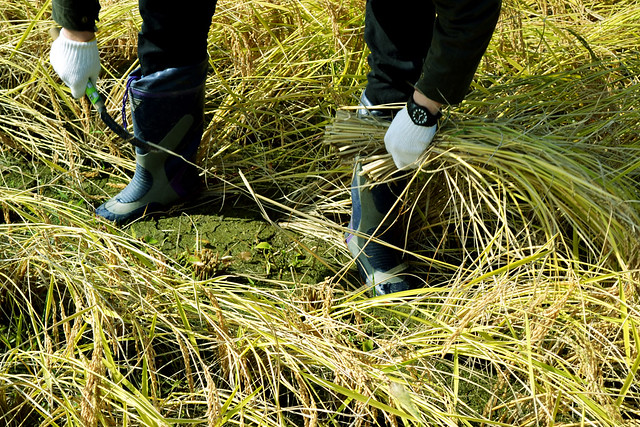 Photo by Yoko Kumano
Photo by Yoko Kumano
 Charlie Hallowell. Photo by Kelly Ishikawa
Charlie Hallowell. Photo by Kelly Ishikawa
 Photo by Kelly Ishikawa
Photo by Kelly Ishikawa
We placed each rice bunch on metal poles, for drying. It was incredible to watch the pole fill up, inch by inch, until there was no more room. We even had to set up additional poles for more space!
 Artist David Wilson. Photo by Kelly Ishikawa
Artist David Wilson. Photo by Kelly Ishikawa
 Success! Photo by Kelly Ishikawa
Success! Photo by Kelly Ishikawa
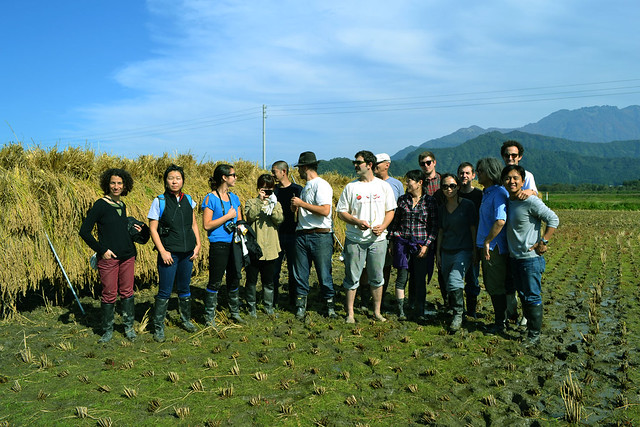 The OPEN, and Food Light Project crew. Photo by Yoko Kumano
The OPEN, and Food Light Project crew. Photo by Yoko Kumano
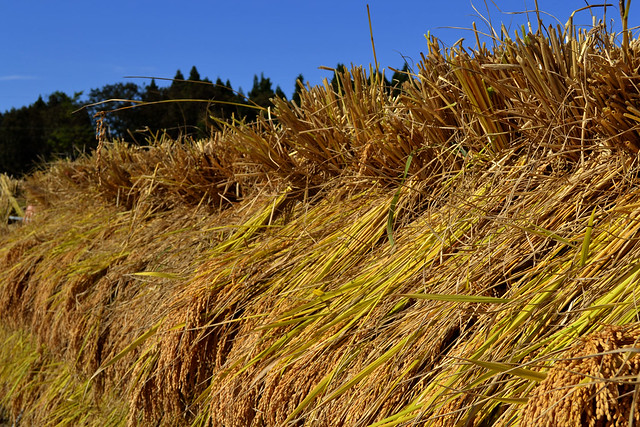 Photo by Yoko Kumano
Photo by Yoko Kumano
After gathering the harvest, which took about three hours, we were treated to
onigiri (rice balls), made with
koshihikari rice.
Hikari means "shine", and the rice does just that. Brightly
.
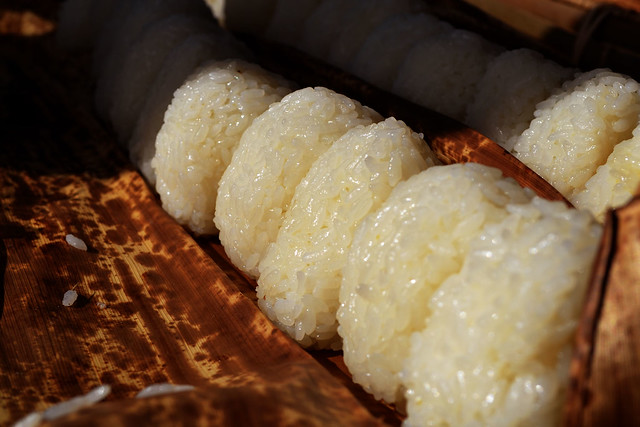 Onigiri (rice balls). Photo by Yoko Kumano
Onigiri (rice balls). Photo by Yoko Kumano
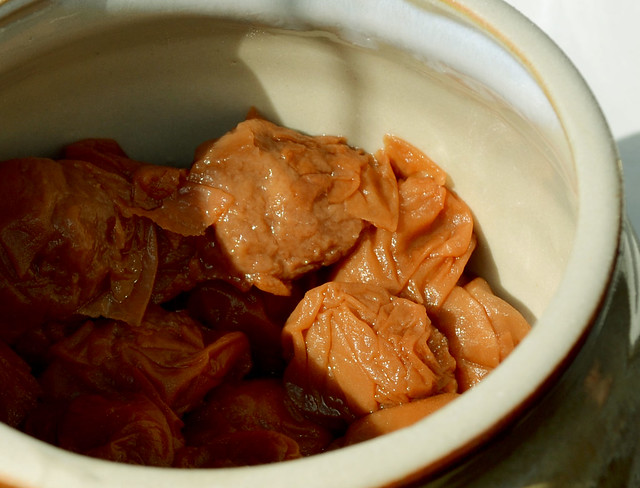 Umeboshi (pickled plum). Photo by Yoko Kumano
Umeboshi (pickled plum). Photo by Yoko Kumano
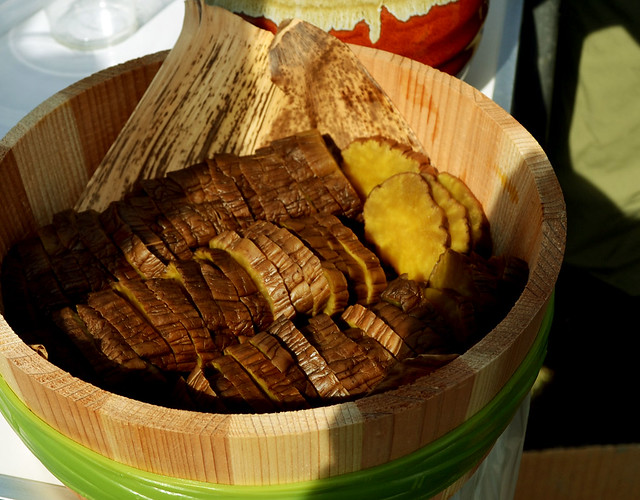 Takuwan (pickled radish). Photo by Yoko Kumano
Takuwan (pickled radish). Photo by Yoko Kumano
 Photo by Yoko Kumano
Photo by Yoko Kumano
Growing up, my mom would always warn me at the dinner table that would eyes be sewn shut if any grains of rice were left behind in my bowl. In Japan, every grain of rice is precious, and must be regarded with respect. I imagine that the rice shortage during the war really traumatized the country, as rice is the central component of every meal, and is vital to Japanese culture, through time.
Sam is reading
Rice as Self: Japanese Identity Through Time by
Emiko Ohnuki-Tierny right now, and I am reading the
One Straw Revolution, by
Masanobu Fukuoka. Although Fukuoka is celebrated by many for his revolutionary "Do-Nothing Farming" method, Japan's rice fields are still heavily regulated and monitored by the government. Ehem, corn in the States, anyone? Although I am in no position to speak on the commonalities of these two crops in either countries, I did get a sense that the government has a stronghold on rice, and all its related products, in Japan.
But our host Satoshi Imai did say something that delighted me during our interview. He said, "The diversity of the rice grains, and the ability to use the grain in different ways, makes this so interesting. It would not be so interesting if all the grains were uniform." This celebration of diversity, understanding the terroir, and allowing his crops to take on differences, excited me.
Already on this trip, we've experienced rice take on different forms, be it sake or mochi or our
onigiri. Harvesting rice together as a group, worked as a unifying foundation for OPENharvest--a building ground for all the experiences to come on this trip, leading up to the big event. As Jerome said in the video, the air in Niigata is so fresh, and the physical labor of harvesting helped clear the mind. In this moment, OPENharvest morphed from metaphor to physical. We will never look at a bowl of rice the same, ever again.
 Rice being hung to dry. So satisfying. Photo by Kelly Ishikawa
Rice being hung to dry. So satisfying. Photo by Kelly Ishikawa
*
Top photo by Kelly Ishikawa
**This article was originally posted on the OPENharvest website on October 23, 2011. Stay updated on all OPENharvest events, live in Tokyo, here.
 At 5am on a Thursday morning, groggy and jetlagged, 20 of us OPENharvest participants, with Food Light Project members piled into three vans headed for Niigata prefecture. As we drove through the quiet morning streets of Tokyo, we eagerly anticipated the adventures ahead.
Three hours and several rest stops later, we made it to Uonuma, a region of Niigata well known for the rice, koshihikari. It is a variety of rice that is presently grown all over Japan, but it is here in Uonuma that it originated. According to Satoshi Imai, rice farmer and owner of the Minami Uonuma Farm, koshihikari was discovered in the wartime years, and grows best in Uonuma, due to factors such as the fresh spring water that drips down from Hakkaisan Mountain, which towers over the region; as well as the terroir, or fuudo (watch Yoko Kumano's video on this subject here).
At 5am on a Thursday morning, groggy and jetlagged, 20 of us OPENharvest participants, with Food Light Project members piled into three vans headed for Niigata prefecture. As we drove through the quiet morning streets of Tokyo, we eagerly anticipated the adventures ahead.
Three hours and several rest stops later, we made it to Uonuma, a region of Niigata well known for the rice, koshihikari. It is a variety of rice that is presently grown all over Japan, but it is here in Uonuma that it originated. According to Satoshi Imai, rice farmer and owner of the Minami Uonuma Farm, koshihikari was discovered in the wartime years, and grows best in Uonuma, due to factors such as the fresh spring water that drips down from Hakkaisan Mountain, which towers over the region; as well as the terroir, or fuudo (watch Yoko Kumano's video on this subject here).
 Magazine editor Toru Iwasa and rice farmer Satoshi Imai. Photo by Yoko Kumano
Luckily, the 3/11 disaster did not effect Niigata very much, in terms of farming and production. This surprised me, given how close the prefecture is (just due east of Fukuoka), but there is a large mountain range that divides this part of the country, so they lie on separate seismic plates. Good to know!
We were warmly welcomed to Minami Uonuma Farm, and the field full of rice crops ready for harvesting.
Magazine editor Toru Iwasa and rice farmer Satoshi Imai. Photo by Yoko Kumano
Luckily, the 3/11 disaster did not effect Niigata very much, in terms of farming and production. This surprised me, given how close the prefecture is (just due east of Fukuoka), but there is a large mountain range that divides this part of the country, so they lie on separate seismic plates. Good to know!
We were warmly welcomed to Minami Uonuma Farm, and the field full of rice crops ready for harvesting.
 Photo by Kelly Ishikawa
We grabbed our tools, and slipped on some rain boots. The sun, just starting to peek out from the fog, warmed our faces; the air, crisp and clear, boasted the beginnings of autumn. We were ready for action.
Photo by Kelly Ishikawa
We grabbed our tools, and slipped on some rain boots. The sun, just starting to peek out from the fog, warmed our faces; the air, crisp and clear, boasted the beginnings of autumn. We were ready for action.
 OPENrestaurant co-founder Sam White and Pizzaiolo's Charlie Hallowell. Photo by Yoko Kumano
OPENrestaurant co-founder Sam White and Pizzaiolo's Charlie Hallowell. Photo by Yoko Kumano
 Barefoot Sam White. Photo by Kelly Ishikawa
Chez Panisse chef and OPEN co-founder Jerome Waag explains the steps for collecting the rice:
http://www.youtube.com/watch?v=J1PzwVH5lJk
Video by Kayoko Akabori
About two bunches of crops equals one bowl of rice. There was enough rice here to comfortably feed a family, maybe even a small village, until the next harvest.
Barefoot Sam White. Photo by Kelly Ishikawa
Chez Panisse chef and OPEN co-founder Jerome Waag explains the steps for collecting the rice:
http://www.youtube.com/watch?v=J1PzwVH5lJk
Video by Kayoko Akabori
About two bunches of crops equals one bowl of rice. There was enough rice here to comfortably feed a family, maybe even a small village, until the next harvest.
 Photo by Yoko Kumano
Cultivating rice is extremely difficult. From the moment it is planted, it must be watched with keen, observant eyes, getting a feel for the land and all of its uncertainties. The fields are flooded numerous times, and it takes months of careful cultivation to produce each grain. Crops are laid down in April, ready for harvest in late September. In the harsh winter months here in Niigata, the fields are covered with nearly ten feet of snow! This means it is a time for the soil to rest, and get ready for the next planting season.
Photo by Yoko Kumano
Cultivating rice is extremely difficult. From the moment it is planted, it must be watched with keen, observant eyes, getting a feel for the land and all of its uncertainties. The fields are flooded numerous times, and it takes months of careful cultivation to produce each grain. Crops are laid down in April, ready for harvest in late September. In the harsh winter months here in Niigata, the fields are covered with nearly ten feet of snow! This means it is a time for the soil to rest, and get ready for the next planting season.
 Mack Yokokawa. Photo by Kelly Ishikawa
Mack Yokokawa. Photo by Kelly Ishikawa
 Photo by Yoko Kumano
Photo by Yoko Kumano
 Photo by Kelly Ishikawa
Photo by Kelly Ishikawa
 David Wilson and rice farmer. Photo by Yoko Kumano
David Wilson and rice farmer. Photo by Yoko Kumano
 Photo by Yoko Kumano
Photo by Yoko Kumano
 Charlie Hallowell. Photo by Kelly Ishikawa
Charlie Hallowell. Photo by Kelly Ishikawa
 Photo by Kelly Ishikawa
We placed each rice bunch on metal poles, for drying. It was incredible to watch the pole fill up, inch by inch, until there was no more room. We even had to set up additional poles for more space!
Photo by Kelly Ishikawa
We placed each rice bunch on metal poles, for drying. It was incredible to watch the pole fill up, inch by inch, until there was no more room. We even had to set up additional poles for more space! Artist David Wilson. Photo by Kelly Ishikawa
Artist David Wilson. Photo by Kelly Ishikawa
 Success! Photo by Kelly Ishikawa
Success! Photo by Kelly Ishikawa
 The OPEN, and Food Light Project crew. Photo by Yoko Kumano
The OPEN, and Food Light Project crew. Photo by Yoko Kumano
 Photo by Yoko Kumano
After gathering the harvest, which took about three hours, we were treated to onigiri (rice balls), made with koshihikari rice. Hikari means "shine", and the rice does just that. Brightly.
Photo by Yoko Kumano
After gathering the harvest, which took about three hours, we were treated to onigiri (rice balls), made with koshihikari rice. Hikari means "shine", and the rice does just that. Brightly.
 Onigiri (rice balls). Photo by Yoko Kumano
Onigiri (rice balls). Photo by Yoko Kumano
 Umeboshi (pickled plum). Photo by Yoko Kumano
Umeboshi (pickled plum). Photo by Yoko Kumano
 Takuwan (pickled radish). Photo by Yoko Kumano
Takuwan (pickled radish). Photo by Yoko Kumano
 Photo by Yoko Kumano
Growing up, my mom would always warn me at the dinner table that would eyes be sewn shut if any grains of rice were left behind in my bowl. In Japan, every grain of rice is precious, and must be regarded with respect. I imagine that the rice shortage during the war really traumatized the country, as rice is the central component of every meal, and is vital to Japanese culture, through time.
Sam is reading Rice as Self: Japanese Identity Through Time by Emiko Ohnuki-Tierny right now, and I am reading the One Straw Revolution, by Masanobu Fukuoka. Although Fukuoka is celebrated by many for his revolutionary "Do-Nothing Farming" method, Japan's rice fields are still heavily regulated and monitored by the government. Ehem, corn in the States, anyone? Although I am in no position to speak on the commonalities of these two crops in either countries, I did get a sense that the government has a stronghold on rice, and all its related products, in Japan.
But our host Satoshi Imai did say something that delighted me during our interview. He said, "The diversity of the rice grains, and the ability to use the grain in different ways, makes this so interesting. It would not be so interesting if all the grains were uniform." This celebration of diversity, understanding the terroir, and allowing his crops to take on differences, excited me.
Already on this trip, we've experienced rice take on different forms, be it sake or mochi or our onigiri. Harvesting rice together as a group, worked as a unifying foundation for OPENharvest--a building ground for all the experiences to come on this trip, leading up to the big event. As Jerome said in the video, the air in Niigata is so fresh, and the physical labor of harvesting helped clear the mind. In this moment, OPENharvest morphed from metaphor to physical. We will never look at a bowl of rice the same, ever again.
Photo by Yoko Kumano
Growing up, my mom would always warn me at the dinner table that would eyes be sewn shut if any grains of rice were left behind in my bowl. In Japan, every grain of rice is precious, and must be regarded with respect. I imagine that the rice shortage during the war really traumatized the country, as rice is the central component of every meal, and is vital to Japanese culture, through time.
Sam is reading Rice as Self: Japanese Identity Through Time by Emiko Ohnuki-Tierny right now, and I am reading the One Straw Revolution, by Masanobu Fukuoka. Although Fukuoka is celebrated by many for his revolutionary "Do-Nothing Farming" method, Japan's rice fields are still heavily regulated and monitored by the government. Ehem, corn in the States, anyone? Although I am in no position to speak on the commonalities of these two crops in either countries, I did get a sense that the government has a stronghold on rice, and all its related products, in Japan.
But our host Satoshi Imai did say something that delighted me during our interview. He said, "The diversity of the rice grains, and the ability to use the grain in different ways, makes this so interesting. It would not be so interesting if all the grains were uniform." This celebration of diversity, understanding the terroir, and allowing his crops to take on differences, excited me.
Already on this trip, we've experienced rice take on different forms, be it sake or mochi or our onigiri. Harvesting rice together as a group, worked as a unifying foundation for OPENharvest--a building ground for all the experiences to come on this trip, leading up to the big event. As Jerome said in the video, the air in Niigata is so fresh, and the physical labor of harvesting helped clear the mind. In this moment, OPENharvest morphed from metaphor to physical. We will never look at a bowl of rice the same, ever again.
 Rice being hung to dry. So satisfying. Photo by Kelly Ishikawa
*Top photo by Kelly Ishikawa
**This article was originally posted on the OPENharvest website on October 23, 2011. Stay updated on all OPENharvest events, live in Tokyo, here.
Rice being hung to dry. So satisfying. Photo by Kelly Ishikawa
*Top photo by Kelly Ishikawa
**This article was originally posted on the OPENharvest website on October 23, 2011. Stay updated on all OPENharvest events, live in Tokyo, here.



Comments (9)
this is so momentous! This is like the equivalent of the blow off getting invited to spend three weeks inside someone’s broken heart. Love it. so proud and excited for you guys and I too will never look at a bowl of rice the same. Loved the video too!
I’m impressed,Kayoko!
I wish I was there.
What an exciting experience and the drying rice looks beautiful. I remember my Japanese grandfather also telling me how important it was not to waste even a single grain of rice, and he would clean out his bowl with some green tea.
Forget the tabi…bring me an onigiri! So impressed with you, Kayoko-san!
Wow, this is a great article, Kayo. I too, wish I was there. Really beautiful photos too.
I echo Washi and I’m also proud of you ladies!
お天気に恵まれた楽しい稲刈り、楽しさがつたわります。春には八須さんとところで田植えが体験できます。ぜひ参加してみてください。
This is the coolest thing I have read in months.
Thanks for this excellent post — great photos.
OPENharvest is a wonderful idea: I’ve been following some of the events this week in Tokyo. Lots of fun!